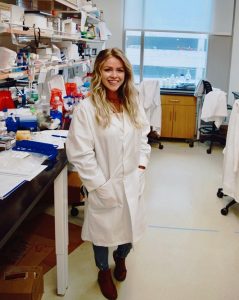 My research focuses on developing next-generation oncology immunotherapeutics. This unique class of drugs aims to modulate the body’s own immune system to recognize and eliminate cancer. With immune checkpoint blockade (ICB) therapy changing the paradigm of cancer treatment, clinicians and scientists are looking for new strategies to improve efficacy and survival in patients whose tumors lack sufficient immune cell activation and infiltration and are poorly responsive to current ICB. One promising approach is to activate the Stimulator of Interferon Genes (STING) Pathway, which has been identified as a key mediator in antitumor immunity due to its ability to generate appropriate proinflammatory cytokines and chemokines that act as chemical cues for immune activation.
My research focuses on developing next-generation oncology immunotherapeutics. This unique class of drugs aims to modulate the body’s own immune system to recognize and eliminate cancer. With immune checkpoint blockade (ICB) therapy changing the paradigm of cancer treatment, clinicians and scientists are looking for new strategies to improve efficacy and survival in patients whose tumors lack sufficient immune cell activation and infiltration and are poorly responsive to current ICB. One promising approach is to activate the Stimulator of Interferon Genes (STING) Pathway, which has been identified as a key mediator in antitumor immunity due to its ability to generate appropriate proinflammatory cytokines and chemokines that act as chemical cues for immune activation.
There are numerous STING agonists that are being explored in both preclinical models and Phase I/II clinical trials. One of the most promising STING agonists is a diamidobenzimidazole (diABZI) small molecule drug designed for systemic administration. Although systemic administration is the most ideal route of delivery for patients, considering most tumors are not readily accessible for intratumoral injection, diABZI activates STING indiscriminately without tumor targeting mechanisms and opens the concern for off-target immune activation and toxicity. Therefore, I have designed a new drug delivery system for diABZI enrichment within the tumor.
Polymer-drug conjugates allow for prolonged drug circulation and improved tumor accumulation through increased molecular weight and enzymatic drug release. I have designed a STING-activating polymer-drug conjugate, SAPCon, that readily accumulates in murine breast tumors, where it preferentially activates STING compared to its small molecular counterpart. This elicits an antitumor response through an increase in activated macrophages, activated dendritic cells, and cytotoxic T cells within the tumor. Following a full therapeutic regime, mice are not only able to clear primary tumors, but can also develop immunological memory, leaving them resistant to tumor rechallenge- a model of recurrence. I have also demonstrated how SAPCon synergizes with standard ICB in a triple-negative breast cancer model to mitigate tumor growth and prolong survival. I am extremely passionate about improving cancer care and have been incredibly grateful to work in such an exciting and promising research area.

VINSE Experience:
Not only does VINSE equip our lab with a plethora of analytical tools to help expedite our research, but also provides us with opportunities to network and mentor. I have participated in VINSE’s NanoDay for several years and have always enjoyed the opportunity to chat with other graduate students of diverse backgrounds and learn about the multidisciplinary research occurring here at Vanderbilt. I am also grateful to have had the opportunity to serve as a graduate student mentor in VINSE’s Summer Undergraduate Research Program. My mentee assisted me in adding a macrophage-targeting moiety to my SAPCon platform and characterized its ability to target tumor-specific macrophages in vitro. This project will continue to serve as motivation for next-generation polymers within our lab. Her experience here ultimately invigorated her decision to pursue a doctorate degree in biomedical engineering, and I am happy to have been a part of that process.